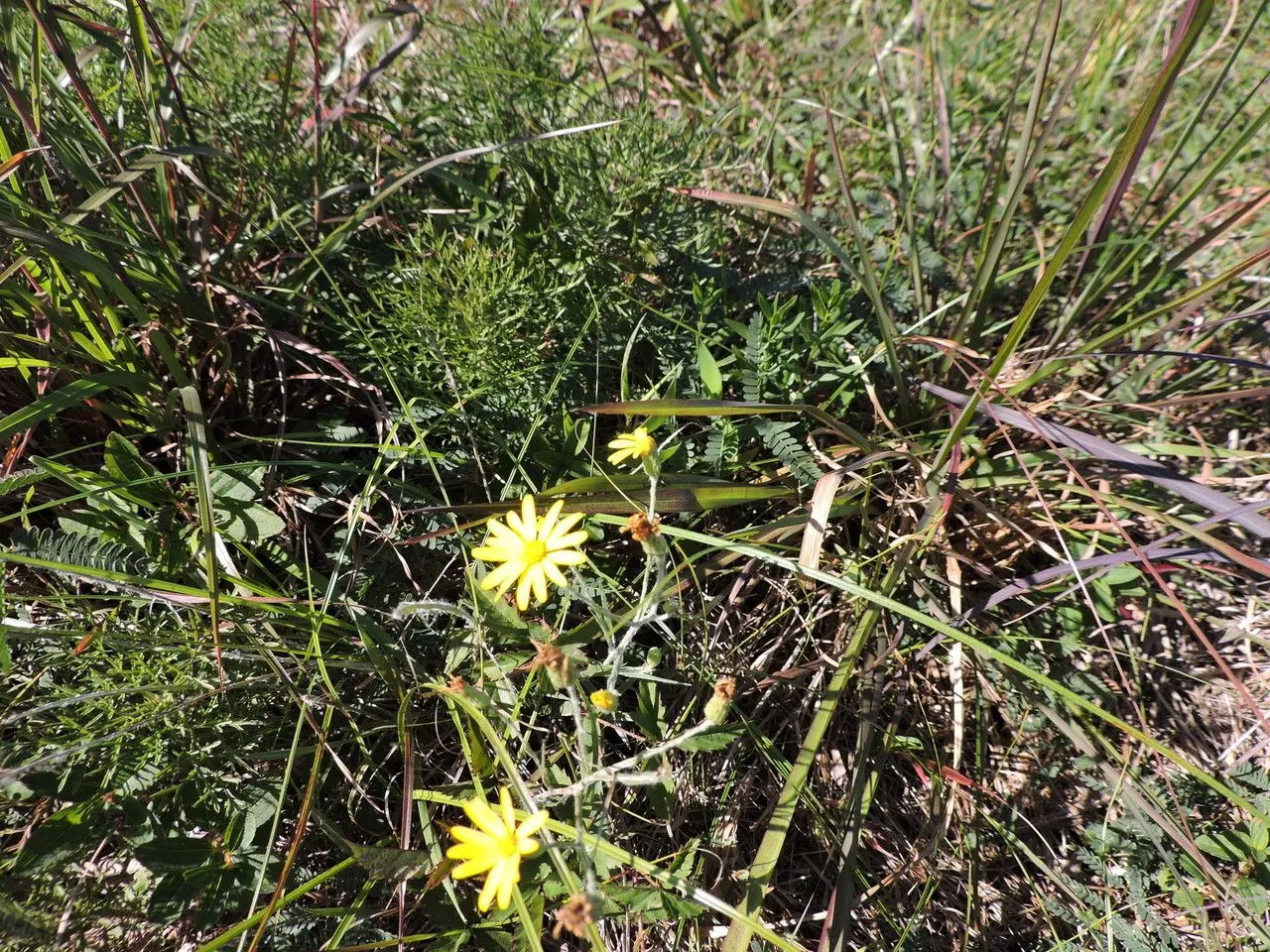
Author: (Michx.) Nutt.
Bibliography: Trans. Amer. Philos. Soc., ser. 2, 7: 317 (1840)
Year: 1840
Status: accepted
Rank: species
Genus: Pityopsis
Vegetable: False
Observations: S. Ohio to Honduras, Bahamas
Grass-leaf golden-aster, with the scientific name Pityopsis graminifolia, is a remarkable perennial plant belonging to the Asteraceae family. Celebrated for its radiant golden-yellow flowers, this species embellishes a variety of landscapes from the southern regions of Ohio, stretching down to Honduras, and extending to the Bahamas. This hardy plant is noted for its resiliency and ability to thrive in diverse environments, making it a versatile addition to both natural and cultivated gardens.
First classified by the esteemed botanist André Michaux and later refined by Thomas Nuttall in 1840, the Grass-leaf golden-aster presents itself as a botanical testament to the intricate beauty of the Asteraceae family. This plant is characterized by its narrow, grass-like leaves, which not only contribute to its name but also serve an ecological function by providing a durable and drought-resistant foliage base.
The golden-yellow blooms of Pityopsis graminifolia unfurl in a spectacular display, typically during late summer to early autumn. Each blossom is composed of numerous delicate petals that form a captivating contrast against the slender green leaves. This vibrant flowering period attracts a plethora of pollinators, including bees and butterflies, thereby playing a significant role in the local ecosystem.
With a natural habitat extending from temperate to tropical zones, the Grass-leaf golden-aster showcases an impressive adaptability. This feature makes it a popular choice for garden enthusiasts seeking a plant that can withstand varying soil types and climatic conditions. Moreover, it has been noted for its low maintenance requirements, making it an ideal option for sustainable landscaping projects.
Research and observations over the years have reinforced the importance of Pityopsis graminifolia within its native range. Its presence contributes not only to the aesthetic value of the areas it inhabits but also to the environmental health by supporting pollinators and offering ground coverage that helps prevent soil erosion.
In summary, the Grass-leaf golden-aster is a plant that commands admiration for its resilience, beauty, and ecological significance. Through its enduring presence from the woodlands of Ohio to the tropical environments of Honduras and the Bahamas, it continues to be a cherished member of the botanical world.
Eng: grass-leaf golden-aster, narrowleaf silkgrass, silk-grass
En: Grass-leaf golden-aster, Silk-grass, Narrowleaf silkgrass
Taken Sep 11, 2004 by EOL − Steven J. Baskauf (cc-by-nc-sa)
Taken Dec 3, 2020 by cthulhu mittens (cc-by-sa)
Taken Jun 10, 2020 by MD MONIRUL ISLAM (cc-by-sa)
Taken Oct 26, 2019 by Derrick Derrick George (cc-by-sa)
Taken Oct 24, 2020 by Alycatt279 (cc-by-sa)
Taken Nov 5, 2014 by EOL − Sam Kieschnick (cc-by-nc)
Taken Oct 23, 2012 by EOL − Richard Spellenberg (cc-by-nc-sa)
Taken Sep 24, 2012 by EOL − Mary Keim (cc-by-nc-sa)
Taken Oct 22, 2012 by EOL − Richard Spellenberg (cc-by-nc-sa)
Taken Feb 18, 2015 by EOL − Richard Spellenberg (cc-by-nc-sa)
Taken Sep 15, 2014 by EOL − Laura Clark (cc-by-nc)
Taken Sep 11, 2004 by EOL − Steven J. Baskauf (cc-by-nc-sa)
Taken Sep 11, 2004 by EOL − Steven J. Baskauf (cc-by-nc-sa)
Taken Oct 23, 2012 by EOL − Richard Spellenberg (cc-by-nc-sa)
Taken Oct 23, 2012 by EOL − Richard Spellenberg (cc-by-nc-sa)
Taken Oct 22, 2012 by EOL − Richard Spellenberg (cc-by-nc-sa)
Taken Feb 18, 2015 by EOL − Richard Spellenberg (cc-by-nc-sa)
Taken Jan 17, 2021 by Grace (cc-by-sa)
© copyright of the Board of Trustees of the Royal Botanic Gardens, Kew.
© copyright of the Board of Trustees of the Royal Botanic Gardens, Kew.
Growth form>: Rhizomatous
Growth habit>: Forb/herb
Growth rate>: Slow
Ph maximum: 7.0
Ph minimum: 5.8
Family: Myrtaceae Author: (F.Muell.) K.D.Hill & L.A.S.Johnson Bibliography: Telopea 6: 402 (1995) Year: 1995 Status:…
Family: Rubiaceae Author: Pierre ex A.Froehner Bibliography: Notizbl. Bot. Gart. Berlin-Dahlem 1: 237 (1897) Year:…
Family: Sapindaceae Author: Koidz. Bibliography: J. Coll. Sci. Imp. Univ. Tokyo 32(1): 38 (1911) Year:…
Family: Asteraceae Author: A.Gray Bibliography: Pacif. Railr. Rep.: 107 (1857) Year: 1857 Status: accepted Rank:…
Family: Fabaceae Author: Medik. Bibliography: Vorles. Churpfälz. Phys.-Ökon. Ges. 2: 398 (1787) Year: 1787 Status:…
Family: Aspleniaceae Author: (Cav.) Alston Bibliography: Bull. Misc. Inform. Kew 1932: 309 (1932) Year: 1932…